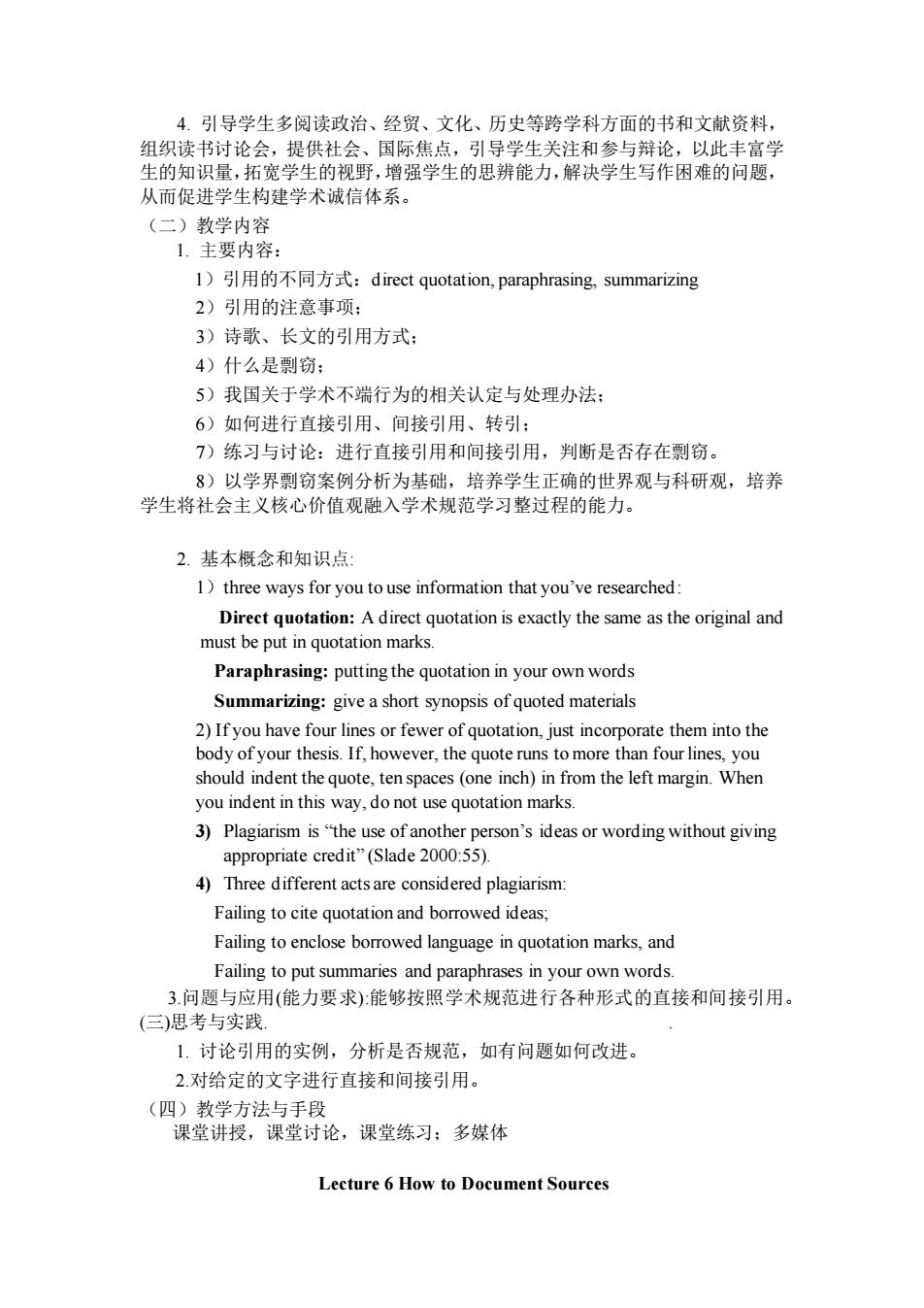正在加载图片...

4.引导学生多阅读政治、经贸、文化、历史等跨学科方面的书和文献资料, 组织读书讨论会,提供社会、国际焦点,引导学生关注和参与辩论,以此丰富学 生的知识量,拓宽学生的视野,增强学生的思辨能力,解决学生写作困难的问题, 从而促进学生构建学术诚信体系。 (二)教学内容 1.主要内容 1)引用的不同方式:direct quotation,paraphrasing,summarizing 2)引用的注意事项 3)诗歌、长文的引用方式 4)什么是剽窃: 5)我国关于学术不端行为的相关认定与处理办法 6)如何进行直接引用、间接引用、转引: 7)练习与讨论:进行直接引用和间接引用,判断是否存在剽窃。 8)以学界剩窃案例分析为基础,培养学生正确的世界观与科研观,培养 学生将社会主义核心价值观融入学术规范学习整过程的能力。 2基本概念和知识点 1 three ways for you to use information that you've researched Direet quotation:A direct quotation is exactly the same as the original and must be put in quotation marks Paraphrasing:putting the quotation in your own words Summarizing:give a short synopsis of quoted materials 2)Ifyou have four lines or fewer of quotation,just incorporate them into the body of your thesis.If.however,the quote runs to more than four lines,you should indent the quote,ten spaces(one inch)in from the left margin.When you indent in this way.do not use quotation marks 3)Plagiarism is"the use of another person's ideas or wording without giving appropriate credit"(Slade 2000:55). 4)Three different actsare considered plagiarism Failing to cite quotation and borrowed ideas; Failing to enclose borrowed language in quotation marks,and Failing to put summaries and paraphrases in your own words 3.问题与应用(能力要求):能够按照学术规范进行各种形式的直接和间接引用。 (三)思考与实践 1.讨论引用的实例,分析是否规范,如有问题如何改进。 2对给定的文字进行直接和间接引用。 (四)教学方法与手段 课堂讲授,课堂讨论,课堂练习;多媒体 Lecture 6 How to Document Sources 4. 引导学生多阅读政治、经贸、文化、历史等跨学科方面的书和文献资料, 组织读书讨论会,提供社会、国际焦点,引导学生关注和参与辩论,以此丰富学 生的知识量,拓宽学生的视野,增强学生的思辨能力,解决学生写作困难的问题, 从而促进学生构建学术诚信体系。 (二)教学内容 1. 主要内容: 1)引用的不同方式:direct quotation, paraphrasing, summarizing 2)引用的注意事项; 3)诗歌、长文的引用方式; 4)什么是剽窃; 5)我国关于学术不端行为的相关认定与处理办法; 6)如何进行直接引用、间接引用、转引; 7)练习与讨论:进行直接引用和间接引用,判断是否存在剽窃。 8)以学界剽窃案例分析为基础,培养学生正确的世界观与科研观,培养 学生将社会主义核心价值观融入学术规范学习整过程的能力。 2. 基本概念和知识点: 1)three ways for you to use information that you’ve researched: Direct quotation: A direct quotation is exactly the same as the original and must be put in quotation marks. Paraphrasing: putting the quotation in your own words Summarizing: give a short synopsis of quoted materials 2) If you have four lines or fewer of quotation, just incorporate them into the body of your thesis. If, however, the quote runs to more than four lines, you should indent the quote, ten spaces (one inch) in from the left margin. When you indent in this way, do not use quotation marks. 3) Plagiarism is “the use of another person’s ideas or wording without giving appropriate credit” (Slade 2000:55). 4) Three different acts are considered plagiarism: Failing to cite quotation and borrowed ideas; Failing to enclose borrowed language in quotation marks, and Failing to put summaries and paraphrases in your own words. 3.问题与应用(能力要求):能够按照学术规范进行各种形式的直接和间接引用。 (三)思考与实践. . 1. 讨论引用的实例,分析是否规范,如有问题如何改进。 2.对给定的文字进行直接和间接引用。 (四)教学方法与手段 课堂讲授,课堂讨论,课堂练习;多媒体 Lecture 6 How to Document Sources